Wormholes and other means of providing instant access between distant fixed points1 are narratively convenient. They make it possible to get characters from point A to point B without dying of old age en route. Wormholes (or their equivalent) constrain interstellar travel so that, for example, people cannot simply flee combat by going FTL, nor can they emerge above a planet before their photons arrive to carry out an unstoppable bombing run.2 From an authorial perspective, such constraints are very, very useful.
Once their attention had been drawn to wormholes some time in the 1980s, authors leapt on the chance to use them in fiction. See, for example, how frequently the phrase appears3 in American English.
Which isn’t to say that all authors have used the same kind of wormholes to fix plot holes. Consider these five examples:
Starman Jones by Robert Heinlein (1953)
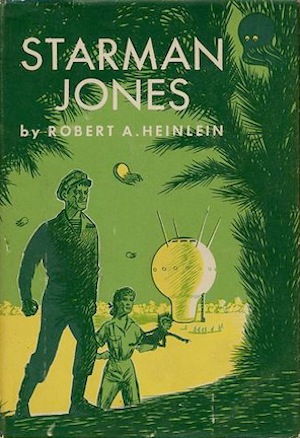
This novel long predates the heyday of wormholes; it doesn’t even use the phrase. But it uses spacetime anomalies, which are just like wormholes. With one exception: they don’t just have an entrance and an exit. They can take you all sorts of interesting places if you enter the anomaly with the wrong approach vector. A small error calculating the vector and a hapless ship could find itself light-millennia off-course, with no clear idea how to get home. No prizes for guessing if this happens to the Asgard, the very ship on which the eponymous Starman Jones is serving. Nor is this worst that will happen to the unfortunate castaways.
***
Starrigger by John DeChancie (1983)
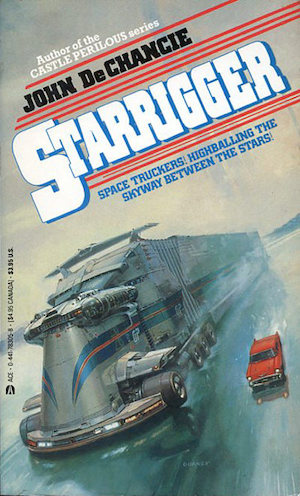
The Skyway that connects the known worlds is unusually user-friendly. The sufficiently advanced aliens who created the Skyway planted their Kerr-Tipler objects on the surfaces of habitable worlds, allowing truckers like Jake to travel from world to world (provided only that their sufficiently robust vehicles follow a precise path past the rapidly spinning, hyperdense towers). At present, human knowledge of the Skyway is rudimentary. However, if someone were to come into possession of the fabled (and quite possibly mythical) Roadmap, a multitude of routes would be open: routes through space and even time. Which is why when whispers begin circulating that Jake has the Roadmap, his life gets very complicated indeed.
***
Antares Dawn by Michael McCollum (1986)
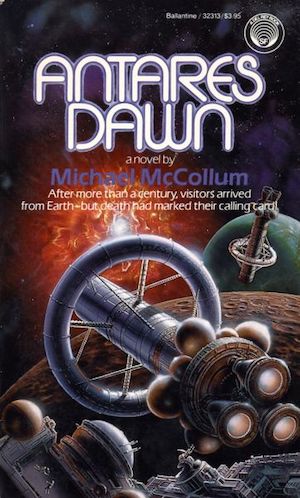
The foldlines—wormholes by another name—that facilitate interstellar travel in McCollum’s Antares series are the product of entirely natural forces. Several centuries into the Great Migration, humanity discovered foldlines had an interesting quirk. When the forces shaping them change, so too do the networks of foldlines. The Antares supernova shuffled local foldlines, leaving the Valeria system isolated for centuries. The eventual appearance of a ship from outside the system sparks celebration.
It turns out that there is little reason to celebrate. The battered TSNS Conqueror brings news of a war between humans and aliens—a war in which the alien side is determined to exterminate their human enemies.
***
There and Back Again by Pat Murphy (1999)
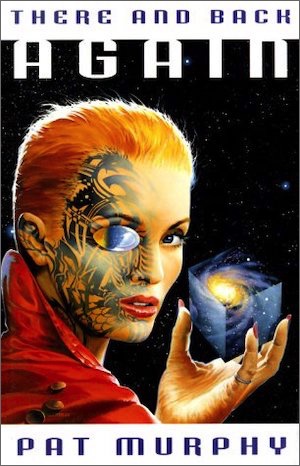
As it so often the case, the aliens who created the network of wormholes laced through the Milky Way did not see fit to leave either a user’s manual or even a map. Humans had to learn the peculiarities of the wormholes. through trial and error. One characteristic was soon obvious: wormholes are one-way. Getting home requires either negotiating a loop of wormholes (if one exists) or decades—even millennia—of sublight travel.
None of which should matter to norbit Bailey Beldon, content as he is to live in his cozy asteroid habitat. Unfortunately for Bailey, the honest norbit informs the Farr clone family that he is in possession of a battered message beacon addressed to the Farrs. Bailey simply wants to hand over the Farrs’ property…getting conscripted into a quite possibly one-way quest for mythical treasure is an unpleasant, unwanted extra.
***
Banner of Souls by Liz Williams (2004)

The Chain (yet another name for wormholes) facilitates rapid travel between the Solar System’s worlds by side-stepping through the Eldritch Realm, the realm of the dead. Convenience is purchased with exposure to Cosmic Horror.
This fact is not what occupies the characters in this novel. In their society, all reproduction is artificial and purposeful: individuals are created to fill a particular niche or serve a given end. Martian warrior Dreams-of-War’s purpose, for example, is to protect young Lunae, a living weapon who may mean the difference between a grim future and one that is much, much worse.
***
No doubt you have your own favourite variations on the basic theme of wormholes. Tell us about them. You will find a handy comment section below.
Originally published April 2021.
In the words of Wikipedia editor TexasAndroid, prolific book reviewer and perennial Darwin Award nominee James Davis Nicoll is of “questionable notability.” His work has appeared in Publishers Weekly and Romantic Times as well as on his own websites, James Nicoll Reviews and Young People Read Old SFF(where he is assisted by editor Karen Lofstrom and web person Adrienne L. Travis). He is a four-time finalist for the Best Fan Writer Hugo Award and is surprisingly flammable.
[1]Taking into account that STARS MOVE.
[2]Or in the case of David Drake’s “Forlorn Hope,” *almost* unstoppable.
[3]Granted, some of the mentions that show in the Ngram viewer will be references to actual holes made by actual worms. I suspect, however, that the bulk of the surge in frequency is thanks to Carl Sagan’s 1985 “Contact,” for which Kip Thorne provided valuable input re: wormholes (https://en.wikipedia.org/wiki/Kip_Thorne).










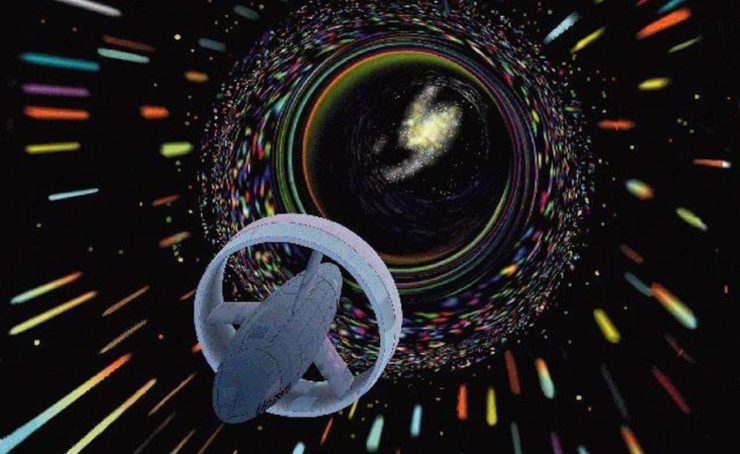
I’m very fond of Starman Jones. So much so, I’m willing to overlook Heinlein’s failure to anticipate the invention of the pocket calculator.
I read somewhere that Heinlein got the idea for the book after reading about a guy who was rescued off the coast of Oregan by an outward-bound trading vessel and was forced to sign on as a deck hand. No wormholes or malevolent aliens, but, like Jones, he returned home in command of the vessel.
Philip Reeves’s novel Railhead also features wormholes on the surfaces of planets; as the title suggests, interstellar travel in this setting is conducted by rail, with artificially intelligent trains handling the transits by themselves. A far cry from First Great Western, I have to say.
In Greg Egan’s Disapora, it’s discovered that every particle — neutron, proton, electron, muon, what have you — is actually a wormhole mouth. This generates great excitement; if they could just enlarge the mouth to allow traveling through the wormhole, they’d get to go anywhere fast.
[rot13]Hasbeghangryl, vg gheaf bhg gung gur yratgu bs gur jbezubyr guebng vf rknpgyl rdhny gb gur qvfgnapr orgjrra gur zbhguf.[/rot13]
Interstellar travel in Haldeman’s The Forever War is facilitated by (nearly?) instantaneous jumps from one ‘collapsar’ to another, but is otherwise sub-lightspeed. Whether Haldeman had heard of wormholes or not, it sounds similar.
The plot of Iain M. Banks’ The Algebraist is driven in large part by the hunt for a special key to a wormhole network.
The Starfire board game featured a wormhole network populated by many interesting (and hostile) species; David Weber did several novels set in that universe.
Okay, first, this quote:
Or without having everyone else die of old age while the travelers hurtle on at relativistic speeds.
Then, recall The Mote in God’s Eye had the Moties find a “crazy Eddie” point which seemed to work like a wormhole, if I recall the story right. The Alderson Drive was used in other works as well.
The song “Convoy” + SF = Starrigger?
I think so.
Nice to see a mention of Michael McCollum, a great author who deserves to be more widely read.
Ken MacLeod’s Newton’s Wake: A Space Opera, features wormholes and James’s favorites: Combat Archeologists and Post Human Societies! It’s a fun read, as MacLeod is an arnachosocialist.
Gee, Issac, noble of you to “forgive” Robert Heinlein anything….he is only one of the three FOUNDERs of true sci fi! And, Starman Jones would today be YA, something else Mr. Heinlein did; he foresaw the need for literature designed for youngsters and that providing it would create an audience life long. He became ever more peculiar and annoying as he aged, but he knew how to write a story! So, even if he in your opinion did not foresee the handheld, he has given us all so much. On the other hand, perhaps he DID foresee it and hoped we’d avoid it if he did not mention it thereby saving society and conversation?
Bujold’s Barrayar books have a small natural network of wormholes. If the wormholes shift, a world can be cut off, and then returned to the network.
A take on wormholes is Robert Reed’s Beyond the Veil of Stars, where “gates” permit mind transference between worlds. Of course, like many of Robert Reed’s books, the writing is much better than the science[1].
———–
1: In much of sf not only is the writing poor (it has gotten better since the “Golden Age”) but the science is terrible, frequently worse than the execrable writing.
Banner of Souls sounds like Warhammer 40k’s system of travel, in which you literally go through a hell of hungry gods and eldritch terrors while being buffeted by ‘warp tides’ and ‘warp storms’.
While I enjoyed Starman Jones, Heinlein’s best wormhole story has to be Tunnel in the Sky. Another YA type story, but one I wrote enjoyed.
Because I am in a surreal mood:
James and the Giant Peach
I’m going to mention The Forgotten Door, a children’s novel of 1965 by Alexander Key, who a few years later wrote Escape to Witch Mountain, which became a Disney film. It tells the story of Young Jon, who falls through what can only be a wormhole and lands on Earth, sans memory. What follows is essentially ET: The Extra-Terrestrial, 17 years before that film was made. I remember reading it when I was quite young, and it was one of my favourite books at the time. Apparently, ABC Weekend Television (part of ITV) made a series based on it back in 1966, but IMDB says that all the episodes appear to have been lost.
Update: Apparently, you can put on a play based on the novel, if you like.
Stephen Baxter’s Ring and Timelike Infinity do some really interesting things with wormholes.
Ian Stewart wrote two stories (“Displaced Persons” and “Captives of the Slavestone”) on a planet where plants and animals evolved to use wormholes, leading to strange creatures that could have bodies made of separate parts connected only by the wormholes (and then a human colony landed their, lost their technology, but adapted their own odd uses of the wormholes).
Love the Baxter books @17 and I’d also recommend John Barnes’ A Million Open Doors, where the wormhole “springer” technology and its effects on society (think globalization) are the central focus. Book one of the “Thousand Cultures” series.
2001: A Space Odyssey and in fact 2010: Odyssey Two should have made this list. Smaller spoiler: the monolith did it.
> So much so, I’m willing to overlook Heinlein’s failure to anticipate the invention of the pocket calculator.
This miniaturization of computers was something that none of the early SF authors seemed to predict. Not even Clarke, who was good at predicting. Did anyone figure it out? Maybe Jerry Pournelle?
There was an old tone sf story in which data storage got so dense all human information fit on a single device… whose index got lost.
@22: That sounds like “MS Fnd in a Lbry”, by Hal Draper.
@21- Asimov’s “The Last Question,” had miniaturization- of a sort- Microvacs, after the first time jump take up only half a spaceship, considerably down from the city-sized Multivac. The Universal AC, later, appears to be only two feet in diameter, though it cheats a bit by using hyperspace.
Does any one remember Stephen Goldin’s Jade Darcy series? Those book has a strange god-like character that moves people through space with its own “wormhole”- I think. To me it read like a large fright elevator. I have no idea how that “wormhole” worked but the cast of character is pretty interesting.
@21: Pournelle is hardly an early writer; he won the best-new-writer vote in 1973, when desktop computers were already available. (Yes, they were feeble — but they didn’t need a refrigerated extra-large room.) He did write about real-world computers as the ones cheap enough for a person to own got powerful enough to be interesting; ISTR that many were signed “J. E. Pournelle, PhD”.
@21, @24: What about Asimov’s That Feeling of Power, which is all about the rediscovery of how to multiply and divide when people all have pocket computers?
@21
Murray Leinster, A Logic Named Joe, 1948.
I’m surprised it took till comment 11 for Bujold to be mentioned. Are people starting to forget her Vorkosigan novels?